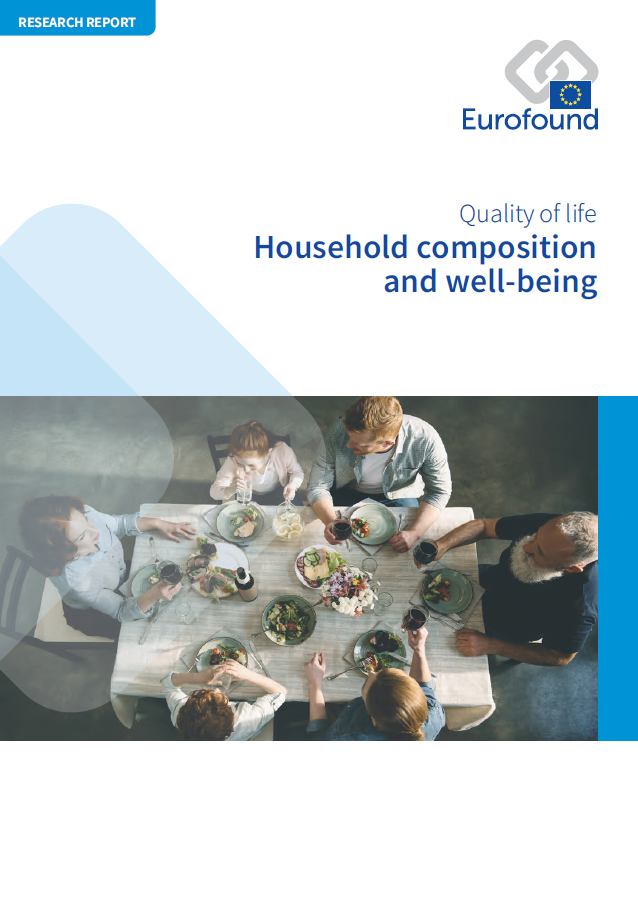
Demographic change, social progress and economic cycles have impacted household composition in Europe. This report provides an overview of household types in the European Union, how they have changed over the period 2007–2017 and how household type relates to outcomes in terms of living conditions and well-being – such as life satisfaction, the feeling of social exclusion and mental well-being. Changes in household structure have a potential impact on demand for public services and social benefits. The report also discusses the policy implications of changing household composition and recent policies responding to the increasing diversity of households. The report underlines the importance of recognition of diverse family forms, of the provision of social support, and of family policy measures complementing income support in reducing inequality of well-being among households.
- Table 1: Social exclusion, mental well-being and loneliness, by age, EU28, 2016
- Table 2: Associated factors of well-being measures in single-person households, EU28, 2016
- Table 3: Examples of projects and policies aimed at types of single-person households
- Table 4: Regression coefficients for well-being measures, unmarried people with a partner, EU28, 2016
- Table 5: Rate of cohabitation and rights of cohabiting couples in EU countries
- Table 6: Regression coefficients for various well-being measures for couples without children, of working age and 65+, EU28, 2016
- Table 7: Well-being of people living in same-sex and opposite-sex couples, EU28, 2016
- Table 8: Well-being of retired people, by household type and sex, EU28, 2016
- Table 9: Well-being of parents in nuclear families in comparison with other households, EU28, 2016
- Table 10: Care, work–life balance and time spent on some activities, EU28, 2016
- Table 11: Examples of recent policies aimed at nuclear family households
- Table 12: Well-being of parents in nuclear family households by number of children, EU28, 2016
- Table 13: Living in urban and rural areas, lone parents and couple parents, EU28, 2016 (%)
- Table 14: Subjective and mental well-being of lone parents and couple parents, EU28, 2016
- Table 15: Regression coefficients for life satisfaction and social exclusion, working-age lone parents, EU28, 2016
- Table 16: Blended families in Europe, latest available data published in national statistics
- Table 17: Aspects of housing for blended families, lone-parent and couple-parent households, EU28, 2016
- Table 18: Well-being of parents in blended families, EU28, 2016
- Table 19: Health and school outcomes, by age and household type, EU28, 2014 (%)
- Table 20: Well-being of parents in multigenerational households and nuclear families, EU28, 2016
- Table 21: Standard of living and care responsibilities of parents in multigenerational households and nuclear families, EU28, 2016
- Table 22: Childcare in multigenerational households and nuclear family households, by urbanisation, EU28, 2016 (%)
- Table 23: Associated factors of life satisfaction, working-age parents, EU28, 2016
- Table 24: Determinants of life satisfaction, people aged 65+, EU28, 2016
- Table 25: Material well-being of young adults by household type and age cohort, EU28, 2016
- Table 26: Subjective well-being of young adults by household type, EU28, 2016
- Table 27: Examples of co-living schemes
- Figure 1: Single-person households as a proportion of all households, 2017 (%)
- Figure 2: People living in single-person households as a proportion of total population, 2007 and 2017 (%)
- Figure 3: Housing and deprivation indicators, single- and multi-person households, EU28, 2017 (%)
- Figure 4: Health by age group, people living alone and with others, EU28, 2016 (%)
- Figure 5: Gap in happiness between people living alone and with others, 2016
- Figure 6: Social exclusion of people living alone and with others, 2016
- Figure 7: Cohabiting partners in Europe, 2017 (%)
- Figure 8: Cohabitation rate, 2007 and 2017 (%)
- Figure 9: Correlation between divorce rate and cohabitation rate, 2017
- Figure 10: Life satisfaction of working-age couples, married and cohabiting, 2016
- Figure 11: Prevalence of couple households without children, all ages and working age, 2017 (%)
- Figure 12: Couples without children as a proportion of all couple households, 2007 and 2017 (%)
- Figure 13: Prevalence of same-sex couple households in the EU-SILC dataset, 2017 (%)
- Figure 14: Family rights of same-sex couples in the EU, 2019
- Figure 15: Retired couples as a proportion of all households, 2017 (%)
- Figure 16: Retired couples as a proportion of all households, 2007 and 2017 (%)
- Figure 17: Correlation between increase in male life expectancy over 65 and increase in the proportion of retired couples, 2007–2017
- Figure 18: Nuclear family households as a proportion of all households, 2007 and 2017 (%)
- Figure 19: Prevalence of nuclear family households, 2017 (%)
- Figure 20: Households with three or more children as a proportion of all households, 2007 and 2017 (%)
- Figure 21: Lone parents as a proportion of all parents, 2017 (%)
- Figure 22: Lone-parent households as a proportion of all households, 2007 and 2017 (%)
- Figure 23: Use of formal childcare by income quartile, lone parents and couple parents, EU28, 2016 (%)
- Figure 24: Proportion of people living in blended families, selected Member States (%)
- Figure 25: Proportion of people who have stepchildren (%)
- Figure 26: Multigenerational households as a proportion of all households in the EU, 2017 (%)
- Figure 27: Life satisfaction of 11-, 13- and 15-year-olds, living with grandparents and without grandparents, 2016
- Figure 28: Proportion of young people living with parents in the EU, 2017 (%)
- Figure 29: Proportion of young adults living with parents by age and sex, EU28, 2007 and 2017 (%)
- Number of pages
-
78
- Reference nº
-
EF19040
- ISBN
-
978-92-897-2041-0
- Catalogue nº
-
TJ-04-19-743-EN-N
- DOI
-
10.2806/009582
- Permalink
Cite this publication
Eurofound (2019), Household composition and well-being, Publications Office of the European Union, Luxembourg.
